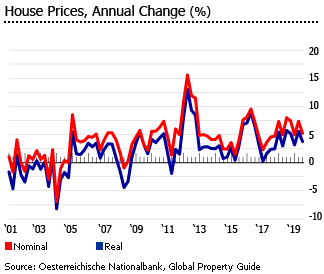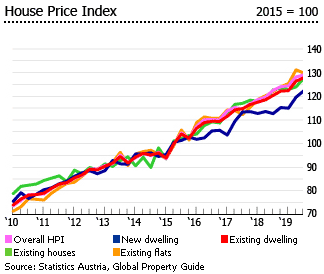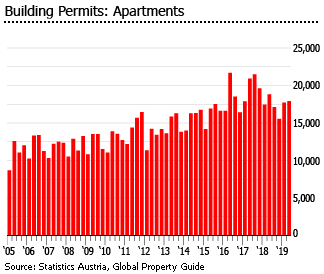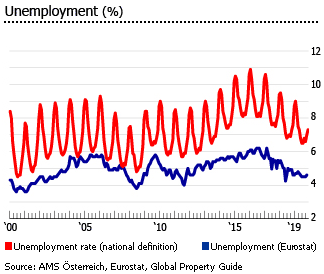Austria’s housing market continues to grow strongly
Austrian housing prices continue to rise strongly, despite a slowing economy. During the year to Q3 2019, the residential property price index in Austria was up by 5.22% (3.77% in real terms), after y-o-y rises of 7.34% in Q2 2019, 4.94% in Q1 2019, 7.4% in Q4 2018, and 7.97% in Q3 2018, based on figures from the Oesterreichische Nationalbank (OeNB). During the latest quarter, nationwide property prices increased 0.8% (0.83% in real terms) in Q3 2019.

- House prices in Vienna, Austria’s capital, rose by 7.62% during the year to Q3 2019 (6.14% in real terms). During the latest quarter, Vienna’s residential property price index increased 0.87% (0.9% in real terms) from the previous quarter.
- In the rest of Austria, the residential property price index rose by 1.82% (0.42% in real terms) in Q3 2019 from a year earlier. In Q3 2019, house prices increased slightly by 0.72% (0.75% in real terms) from the previous quarter.
This is in line with Statistics Austria’s figures, which showed that the overall house price index rose strongly by 6.18% during the year to Q3 2019 (4.72% in real terms), following y-o-y price rises of 6.66% in Q2 2019, 4.15% in Q1 2019, 4.87% in Q4 2018 and 4.9% in Q3 2018. Quarter-on-quarter, house prices increased 1.12% during the latest quarter (1.15% in real terms).
By property type:
- For new dwellings, the average price rose strongly by 8.53% (7.04% in real terms) during the year to Q3 2019, and increased by 2.22% (2.25% in real terms) from the previous quarter, according to Statistics Austria.
- For existing dwellings, the average price increase was 5.32% (3.87% in real terms) in Q3 2019 from a year earlier and 0.69% (0.73% in real terms) from the previous quarter.
- For existing houses, the average price rose by a modest 3.94% (2.51% in real terms) in Q3 2019 from a year earlier and by 2.9% (2.93% in real terms) from the previous quarter.
- For existing flats, the average price was up by 6.43% (4.97% in real terms) y-o-y in Q3 2019, but down by 1.01% (-0.98% in real terms) from the previous quarter.
Supply is falling despite robust demand. In the first half of 2019, the total number of dwellings approved for construction in Austria fell almost 2% y-o-y to 35,623 units, following a 13.7% decline in 2018, according to Statistics Austria. Total housing loans rose by 5.4% in October 2019 from a year earlier, to reach EUR 117.59 billion (US$ 132.09 billion), based on figures from the European Central Bank (ECB).
Yet the economy is slowing. Austria’s economy was estimated to have expanded by 1.6% in 2019, lower than the prior year’s 2.3% growth, as global economic uncertainty dampened domestic activity, according to the Oesterreichische Nationalbank. The Austrian economy is mainly driven by exports, mostly to its biggest trading partner, Germany. The economy is expected to grow by a meagre 1.2% in 2020 and by another 1.4% in 2021, according to the Austrian Institute of Economic Research (WIFO).
There are no restrictions on foreigners buying properties in Austria.
Property transactions continue to rise
The number of housing transactions rose by 6% in 2018 from a year earlier 78,130 units, according to Oesterreichische Nationalbank (OeNB). The value of housing transactions surged 15.3% to EUR 22.58 billion (US$ 25.37 billion). In 2019, property transactions were estimated to have risen further.
“Since the economic crisis in 2008, investors are looking for a safe investment, and interest rates are very low,” said Peter Marschall of Marschall Real Estate in Vienna.

There’s also been higher demand for new apartments, especially from foreign homebuyers. In the high-end residential market, Austrians represent about 60% of property buyers while the remaining 40% are foreigners, mainly from Eastern European countries like Russia and Ukraine, said Marschall. In fact during the year to Q3 2019, prices of new apartments in Vienna and the rest of Austria rose by 7.7% (6.2% in real terms) and 2% (0.6% in real terms), respectively. Wealthy Eastern Europeans are attracted to Austria due to cultural similarities, and see Vienna as a very safe environment and a safe haven for their investments.
Vienna’s "super prime" area, on the other hand, attracts a more diverse set of foreign buyers. Some of these come from Switzerland, the United States, the Middle East, and Hong Kong, according to Otto Immobilien Gruppe’s head of residential marketing, Richard Buxbaum.
According to Bank Austria, the growing number of 25- to 44-year-olds in Austria will raise the demand for housing in the next few years. Over the next ten years, this demographic is expected to increase by an average of 0.5% annually.
Austria has a total population of about 8.9 million. The capital and the largest city of Vienna accounts for more than 20% of the population.
Differences in local house prices
Vienna is ranked as the world’s best city to live in, in terms of quality of life, according to the 21st Mercer Quality of Life study published in 2019. In fact, the Austrian capital has had the world’s highest quality of living for a decade now. The study examined social and economic conditions, health, education, housing and the environment.
“Globally, Vienna tops the ranking for the 10th year running,” said Mercer. “Vienna remains the highest ranking city in Europe and globally, providing resident and expatriates with high security, well-structured public transportation and a variety of cultural and recreation facilities,” Mercer added. It is a no brainer that these qualities have attracted a lot of foreign investors into purchasing homes.
The First District, also called "Innere Stadt", which means "Inner City", is a UNESCO heritage site blessed with baroque architecture as well as the Imperial Palace. The First District is the center of Vienna’s luxury and secondary home market. In January 2020, Innere Stadt apartments cost on average around EUR 14,069 (US$15,804) per sq. m., according to the Immopreise.at. Prices even reach EUR 30,000 (US$ 33,699) per sq. m. in exceptional cases. Slightly lower prices are seen in surrounding areas such as the 2nd to the 9th districts. Prices of condos or villas in the 19th, 18th, and 13th districts range from EUR 5,605 (US$6,296) to EUR7,101 (US$7,976) per sq. m.

In Graz, houses cost, on average, EUR 3,211 (US$ 3,607) per sq. m. in January 2020, according to the Immopreise.at. It is at par with Linz, with an average house price of EUR 3,237 (US$3,636) per sq. m. On the other hand, Salzburg houses cost about twice as much, at around EUR 6,699 (US$ 7,525) per sq. m..
The long boom
House prices in Vienna have been rising consistently since Q3 2004. During first decade of the housing boom (2003-2013), house prices in the capital soared by 99.6% (61.7% in real terms). Property prices in the rest of Austria rose much less, by just 37.1% (11.1% in real terms) from 2003 to 2013. Prices in Vienna rose by 4.2% (2.6% in real terms) in 2014, while prices in the rest of Austria were up by 3.1% (1.4% in real terms).
In the following years, this trend was reversed, as the capital city had become expensive. Vienna’s house prices rose by only 2.2% (1.3% in real terms) in 2015, while prices in the rest of Austria rose by 5.2% (4.2% in real terms). Vienna’s house prices rose by just 3.8% (2.8% in real terms) in 2016 and by 1.5% (-0.7% in real terms) in 2017, while prices in the rest of Austria increased strongly by 9% (8% in real terms) in 2016 and by 4.9% (3.3% in real terms) in 2017.

Then in 2018, Vienna’s house prices rose by 5.2% (3.1% in real terms), while prices in the rest of Austria rose strongly by 8.5% (6.3% in real terms).
Why did Vienna’s house prices rise faster than the rest of Austria from 2004 to 2014? It is puzzling, but it may be partly because it is difficult to build in the centre of Vienna, so new supply is very limited. It may also be because in an era of low interest rates, people are putting money into rental properties, and Vienna offers relatively easy renting (though returns are quite moderate). Another possible factor is that the majority (about 70%) of residential real estate in Vienna is owned by institutional investors, i.e., banks and companies.
Housing permits falling
Housing permits have been falling since last year. In the first half of 2019, the total number of dwellings approved for construction in Austria dropped almost 2% y-o-y to 35,623 units, following a 13.7% decline in 2018, according to Statistics Austria.

Housing permits grew by an average of 9% annually from 2013 to 2017.
The number of new dwellings built in Austria was around 66,000 units yearly in the 1990s, but the number fell to about 40,000 units a year during 2001-2004. Almost 66,000 dwellings were completed in 2018, up from 60,606 units in 2017, 55,970 units in 2016, and 50,100 units in 2015, according to Statistics Austria.
The total housing stock in Austria is currently about 4.65 million. Almost 52% were in multi-storey buildings, while less than 46% were in one- and two-family houses.

Currently, about two-thirds of Viennese citizens live in municipal or publicly subsidized housing, as noted in a recent article in The Guardian. About 80% of flats built in Vienna are financed by the city’s housing subsidy scheme. Vienna’s local government plans a 30% boost in housing construction implying that about 13,000 new homes will be built in Vienna every year, up from the current 10,000.
Rental yields are low to moderate
Austria’s rental market is segmented via tenure, regulation and market forces into a hierarchy of low rents for municipal, other social tenants and long-term incumbents in the private sector, but higher free market rents for recent entrants into the private rental sector (though even the "free" sector is substantially controlled, with maximum rents clearly specified by the authorities). Global Property Guide’s figures cover the "free" market sector only.Rental yields in Vienna’s Innere Stadt (Old Town) are poor as compared to the other upscale areas in Vienna, with yields ranging from only 1.72% for 130-sq. m. apartments to 2.33% for 50 sq. m. apartments, according to Global Property Guide research. At this kind of yield, no-one is buying an apartment to rent it out. These are the residences of the rich.
In Vienna’s other luxurious areas, such as Margereten, Mariahilfen, Favoriten, Hernals, or Leopoldstadt, rental yields range from nearly 5% for very small apartments, to 3% to 4.4% for large apartments.
Outside Vienna, Salzburg apartments offer gross rental yields ranging from 2.4% to 3.8%. Gross rental yields in Graz are slightly better than in Salzburg - ranging from 2.5% to 4.9%. The smallest apartments return the highest rental yields.
An oversupply of rental units during the 1990s led to a fall in rents. The rent decline stopped in 2000 and rents even rose briefly until 2001, but fell once more in 2002. Moreover, the continued increase in home prices in Austria, especially in Vienna, has resulted to a fall in rental yields.
Rising residential rents, large rental market
The average rent per dwelling in the country rose by 4% to EUR 402.2 (US$451.8) per month during the year to Q3 2019, according to Statistics Austria. If measured per square meter, the average rent increased by a more modest 2.7% to EUR 6 (US$6.7) over the same period.
The average rent of dwellings in Vienna rose by 60.3% from 2006 to 2018, slightly higher than the 53% increase for the entire country.
Innere Stadt apartments fetch one of the highest rents in Austria, ranging from EUR 18 (US$20.2) to EUR 22 (US$24.7) per sq. m. per month, according to Global Property Guide research. These rents have not increased in the past three years. Innere Stadt is Vienna’s most luxurious and least populated district, with roughly 17,000 inhabitants. But with a workforce of around 100,000, it is Vienna’s largest employment locale.
In the other upscale districts of Vienna, rents range from EUR 11 (US$12.4) to EUR 19 (US$21.3) per sq. m. per month.
Rents for Salzburg apartments are close to Viennese levels, at around from EUR 12 (US$13.5) to EUR 17 (US$19.1) per sq. m. per month.

Apartments are more affordable in Graz, with rents ranging from EUR 10 (US$11.2) to EUR 14 (US$15.7) per sq. m. per month.
Vienna has one of the highest percentages of renter households in the world, with about 75% of homes rented. In Austria as a whole, households own 56.4% of primary residences, while 41.2% are rented, according to a recent Austrian microcensus. Austria’s home ownership rate is way below the EU-27’s average rate of more than 70%.

The high percentage of rented residential properties is due to the large proportion of subsidized low-rent apartments in the general rental market, according to Martin Schneider of the OeNB. Limited tax incentives for home ownership also contribute to the high proportion of renters.
In Q3 2019, there were about 1,654,100 rented dwellings in Austria, up slightly by 1% from the same period last year, according to Statistics Austria.
Interest rates remain at record lows
In October 2019, the average interest rate for new housing loans fell to 1.44%, from last year’s 1.82% average housing loan rate, according to Oesterreichische Nationalbank (OeNB).

Average interest rates for new loans in October 2019 were:
- Interest rate fixation (IRF) under 1 year: 1.2%, a decline from 1.49% a year earlier and 1.71% two years ago.
- IRF over 1 and up to 5 years: 1.48%, down from 1.66% last year and 1.59% two years ago.
- IRF over 5 years and up to 10 years: 1.71%, down from 2.06% both in October 2018 and October 2017.
- IRF over 10 years: 1.62%, down from 2.25% a year earlier and 2.15% two years ago.
For outstanding housing loans, the average interest rate was 1.74% in October 2019, slightly down from 1.81% in the previous year and 1.85% in October 2017. Over the same period:
- Maturity of up to 1 year: 1.61%, down from 1.74% a year earlier and from 1.75% two years ago.
- Maturity of over 1 and up to 5 years: 1.7%, slightly down from 1.74% a year earlier and from 1.72% two years ago.
- Maturity of over 5 years: 1.74%, down from 1.82% a year earlier and 1.86% two years ago.
The persistently low mortgage rates are partly attributable to the European Central Bank’s (ECB) reduction of its key rate to a record-low of 0.00% in March 2016, where it has remained since.
Mortgage market is still small
In terms of size, the Austrian mortgage market has expanded to 29.5% of GDP in 2019, up from 17.1% of GDP in 2003. Austria is relatively under-mortgaged: the EU’s average is 50% of GDP. As of October 2019, total housing loans stood at EUR 117.59 billion (US$ 132.09 billion), up by 5.4% from a year ago, according to the European Central Bank (ECB).
In Q3 2019, new loans to households for housing purposes rose by 4.62% from a year earlier, according to the OeNB.
The share of foreign-currency denominated mortgage loans is declining. From 18.8% in 2016, its share to total mortgage loans fell to 15.7% in 2017 and finally to just 12.3% in 2018. About 97% of these foreign-currency denominated loans were in Swiss franc (CHF).
Housing loans, as percent of disposable income, stood at 51.1% in Q1 2019, from 52% in 2018, 51.3% in 2017 and 50.2% in 2016, according to the central bank.
Economic slowdown
Austria’s economic growth was estimated to have slowed to 1.6% in 2019, lower than the prior year’s 2.3% growth, as global economic uncertainty dampened domestic activity, according to the Oesterreichische Nationalbank. The Austrian economy is mainly driven by exports, mostly to its biggest trading partner, Germany. More than 75% of Austria’s exports go to Europe, 30% to Germany.

Austria’s economy is expected to grow by a meager 1.2% in 2020 and by another 1.4% in 2021, according to the Austrian Institute of Economic Research (WIFO).
Austria experienced relatively strong economic growth from 2004 to 2007 with an average annual GDP growth of 3%. After contracting by 3.8% in 2009, the economy emerged from recession with growth rates of 1.8% in 2010 and 2.9% in 2011. Though the economy has stagnated in recent years, posting real GDP growth rates of just 0.7% in 2012, 0.03% in 2013, 0.7% in 2014, 1.1% in 2015, and 2% in 2016.
In 2018, Austria unexpectedly recorded its first budget surplus since 1974, as sharp tax revenue growth outpaced expenses. In 2019, the country was estimated to have achieved a surplus equivalent to 0.4% of GDP, a slight improvement from the prior year’s 0.2% surplus, according to the European Commission. The country’s gross public debt was estimated at 69.9% of GDP in 2019, down from 74% in 2018 and 78.2% in 2017, and is projected to drop further to 67.2% of GDP in 2020.
Unemployment was 4.6% in October 2019, slightly down from 4.9% in the same period last year, according to Statistics Austria. Austria’s jobless rate remains well below the Euro area’s average of 7.5% in October 2019.
Inflation stood at 1.1% in November 2019, unchanged from the previous month but down from last year’s 2.2%, according to Statistics Austria. In fact, it was the lowest level in three years. The European Commission expects Austria’s inflation at 1.5% in 2019 and to 1.6% in 2020.
Caps on refugees, coalition deal between the Austrian conservatives and Greens
Austria was among the EU members with the highest numbers of asylum applicants since 2015, with about 90,000 applications. Vienna took in 43,200 people to reach a total population of 1.84 million. Of the 141,718 registered unemployed in the city, around 58,000 were foreigners, representing a 17% annual increase in the number of jobless foreigners in the city.
Aside from having a direct effect on the country’s unemployment rate, Statistics Austria also reported that more than half of all asylum seekers in Austria commit crimes. More specifically, from 2004 to 2014, almost every other migrant had committed some kind of criminal offence after coming to the country and seeking asylum. The report revealed that about 80% of the criminals were young men. Moreover, a number of suspected jihadis were detained in 2016 after a series of raids in cities across Austria.
The government announced in January 2016 that they would set a maximum number of 37,500 asylum applicants annually in the next four years. The following month, Austria introduced a cap of 80 asylum seekers a day allowed to enter the country to make an asylum application, while 3,200 persons are allowed to transit toward other countries.
The government also revealed a plan to deport about 50,000 failed asylum seekers over the next four years.
In fact in February 2016, the Minister of Interior Johanna Mikl-Leitner announced that the "Balkan route", the main passage used by migrants, commonly from the Middle East, to reach affluent countries to the north, would be closed permanently.
From January to November 2019, the Austrian government recorded just 9,749 asylum applications, according to the Federal Ministry for Home Affairs, sharply down from 12,852 asylum applications in the same period last year, 23,151 two years ago and 39,813 three years ago.
In 2019, the number of asylum seekers was capped at 25,000 – lower than the prior year’s 30,000 limit.

The immigration crisis has had a substantial political impact. In the legislative elections of 2013, the Social Democratic Party (SPŐ) and the Austrian People’s Party (ÖVP) - a Christian Democratic party - emerged with the highest number of seats (27% of the vote and 52 seats for the SDP, and 24% and 47 seats for the People’s Party) and formed a ‘grand coalition’.
However in May 2017 the ÖVP elected a new young leader, the right-wing populist Sebastian Kurz. Kurz had previously called for stricter controls onmigrants, and steered through an Islamgesetz (Islam Law) prohibiting the funding of mosques by entities from abroad, paying imams’ salaries, and regulating the version of the Quran that may be used in Austria.
Partly as a result of his leadership the Grand Coalition broke in mid-2017, and a snap election held in October was won by the ÖVP which tool 31.5% of votes and 62 of the 183 seats. The SPŐ was second with 26.9% and 52 seats. The ÖVP disdained its previous socialist partners and formed an alliance with the newly-strong right-wing Freedom Party of Austria (FPÖ) which had finished in 3rd place, receiving 26% of the votes and 51 seats.
The victory of the center-right People’s Party (ÖVP) and the radical right Freedom Party (FPÖ) further strengthened the country’s insistence on restricting immigration and limiting support for immigrants. As Chancellor, Kurz has brought Austria closer to the Visegrad Group, particularly the Eurosceptic and populist governments of Andrej Duda in Poland, Victor Orban in Hungary, and Milos Zeman in the Czech Republic.
The government has stopped the private housing of asylum seekers, providing instead only centralized accommodation facilities. Moreover, it also substantially reduced minimum social welfare support for recognized asylum seekers, reduced access to German courses and apprenticeship programs and take their cash to help pay for basic needs.
As Austria held the EU’s rotating presidency in 2018, Kurz has made curbing unregulated migration a priority not just in the country but in Brussels as well. In fact in October 2018, the Austrian government announced its withdrawal from the UN global migration pact to promote safe and orderly migration (known as the Global Compact for Safe, Orderly and Regular Migration).
However tension between Kurz and his coalition government has increased steadily since it was formed, and the FPÖ’s “Ibizagate” scandal, in which leading FPÖ members were taped agreeing to helping a Russian oligarch with Austrian connections in return for financial support, and revealing contacts with Russian President Putin with a view to forming a "strategic alliance", caused Kurz to be voted out of office in a Parliamentary no confidence vote in May 2019.During the September 2019 snap election, Kurz’s ÖVP won the most votes of 37.5%. The FPÖ suffered heavy losses while the Greens scored their best-ever result, receiving 13.9% of votes, amidst growing calls for urgent action on climate change. In January 1, 2020, Kurz struck a coalition deal with the Greens to ensure his return to power and bring the left-wing party into government for the first time. The Greens will control 4 of 15 ministries.
Sources:
- Residential property price index (RPPI) (Oesterreichische Nationalbank): https://www.oenb.at/isaweb/report.do?lang=EN&report=6.6
- House price index (Statistics Austria): https://www.statistik.at/web_en/statistics/Economy/Prices/house_price_index/index.html
- Further declines in residential construction in the first half of 2019 (Statistics Austria): https://www.statistik.at/web_en/statistics/PeopleSociety/housing/construction_of_buildings_and_dwellings/building_permits/index.html
- Lending rates – new business (Oesterreichische Nationalbank): https://www.oenb.at/isaweb/report.do?lang=EN&report=2.10
- Deposit and lending rates1 - outstanding amounts (Oesterreichische Nationalbank): https://www.oenb.at/isaweb/report.do;jsessionid=D5386504A749C7A5138A553F4BE3D5D1?report=2.8
- Debt Secured by Mortgage and Housing Loans - Banking Sectors (Oesterreichische Nationalbank): https://www.oenb.at/isaweb/report.do?lang=EN&report=3.19
- Housing costs (Statistics Austria): http://www.statistik.at/web_en/statistics/PeopleSociety/housing/housing_costs/index.html
- Prices have risen significantly in Vienna, and yields are moderate (Global Property Guide): https://www.globalpropertyguide.com/Europe/Austria/Rental-Yields
- Housing (Statistics Austria): http://www.statistik.at/web_en/statistics/PeopleSociety/housing/index.html
- Vienna tops Mercer’s 21st quality of living ranking (Mercer): https://www.mercer.com/newsroom/2019-quality-of-living-survey.html
- The price index for real estate in Austria (immopreise.at): https://immopreise.at/Preisentwicklung/Wien/Wien-1-Innere-Stadt/Wohnung/Eigentum
- Economic forecast for Austria (European Commission): https://ec.europa.eu/info/business-economy-euro/economic-performance-and-forecasts/economic-performance-country/austria/economic-forecast-austria_en
- Eurozone unemployment’s falls to lowest rate since July 2008 (The Associated Press): https://apnews.com/0c2bcaa6711d4397957956a9482ad1ef
- Consumer price index (Statistics Austria): http://www.statistik.at/web_en/statistics/Economy/Prices/consumer_price_index_cpi_hcpi/index.html
- Austria Asylum Applications (Trading Economics): https://tradingeconomics.com/austria/asylum-applications
- Asyl (Federal Ministry for Home Affairs): https://www.bmi.gv.at/301/Statistiken/start.aspx#jahr
- Austria country profile (BBC News): https://www.bbc.com/news/world-europe-17405422
- Austria's Kurz sees new government by early next year (The Local): https://www.thelocal.at/20191228/austrias-kurz-sees-new-government-by-early-next-year
- Austrian Conservatives, Greens Strike Coalition Deal (Voice of America): https://www.voanews.com/europe/austrian-conservatives-greens-strike-coalition-deal
- Economic outlook for Austria (Oesterreichische Nationalbank): https://www.oenb.at/en/Monetary-Policy/Economic-Outlook-for-Austria.html
- Global Economic Weakness Dampens Activity in Austria (WIFO): https://www.wifo.ac.at/en/news/global_economic_weakness_dampens_activity_in_austria
- World Economic Outlook Database, October 2019 (International Monetary Fund): https://www.imf.org/external/pubs/ft/weo/2019/02/weodata/weorept.aspx?
- Labor market indicators (Oesterreichische Nationalbank): https://www.oenb.at/isaweb/report.do?lang=EN&report=7.17